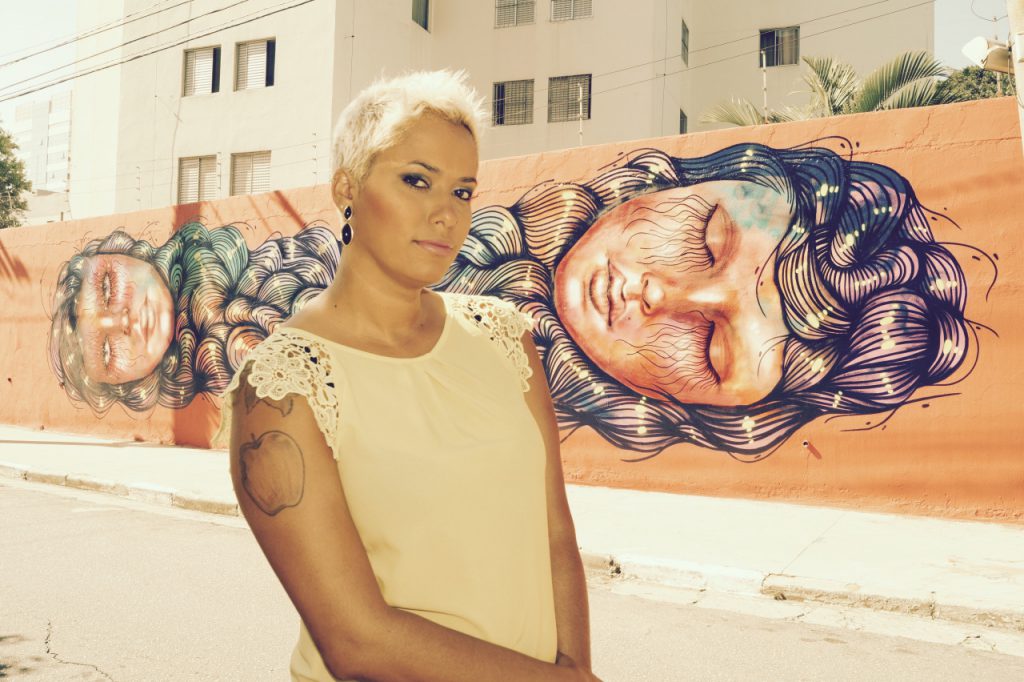Panmela Castro found two tools to get ideas about women’s rights into the everyday lives of ordinary Brazilians: a can of spray paint and a wall.
An internationally renowned graffiti artist and feminist activist, Castro fills public spaces with paintings that highlight gender inequality and challenge patriarchal norms in sexism, sexuality and power.
She got her start a decade ago when Brazil passed its landmark Maria da Penha Law on domestic violence against women in 2006 – the country’s first law to give teeth to protections for women. Castro was inspired to use her art as activism.
Since 2010, she has been founder and president of Rede Nami, a feminist group that uses urban art forms to promote women’s rights. Rede Nami runs graffiti workshops that have had more than 5,000 participants learn the art form and create works that confront racism and violence.
“As soon as we schedule a graffiti workshop and announce that the theme is women, women’s registrations soar,” Castro says. “Graffiti is a good time and people like that, but in these workshops, women’s presence feels more accepted – more acceptable.”
Castro spoke with Women and Girls Hub about changing Brazilian attitudes and actions toward women.
Women and Girls Hub: Rede Nami combines graffiti – an art form that historically has been marginalized – with feminism and women’s rights. Where does this connection come from?
Panmela Castro: I was a victim of domestic violence. Through the hip-hop scene, I became aware of human rights and feminism; before that, there wasn’t anyone in my life who introduced those ideas to me. When I discovered graffiti, I saw that within it there was a discussion and a dialogue about these issues that I’d never noticed before.
As I became a graffiti artist and a feminist, I resolved to use my art and my knowledge to contribute to awakening others. To help other girls discover these ideas, I founded Rede Nami – and it really grew. As soon as I started calling my female friends, they called their female friends, and it took off.
Women and Girls Hub: How did you begin focusing on making graffiti paintings of women?
Castro: In the beginning, my graffiti was very masculine, Because of that, I earned respect in the scene: There was “boy’s graffiti” and “girl’s graffiti” – the latter composed of flowers and dolls. I made graffiti that people called boy’s graffiti, so I ended up being accepted. Once I was accepted, I realized what was happening: The boys told me that my graffiti was “so good that it didn’t seem like a woman made it.”
As soon as I realized that, I resolved to make graffiti that combats violence against women. Graffiti happens in public spaces, and those spaces are very risky for the female body. With these paintings, we occupy those spaces and demand women be respected within them. I came into myself as a woman and made a point to create hyperfeminine work to put a little femininity into the street to force it to accept me within this masculine space.

Women and Girls Hub: When you paint these women, who do they represent, and why?
Castro: People always ask me this question and I never know how to respond, because a painting is very subjective. I don’t like to say that it’s the expression of my own feelings or experiences, or the experiences of the women I meet, because I don’t consider this to be art on a wall but rather a female body in dialogue with the city: a dialogue with everything you have to deal with, and go through, until you reach that point on the wall. In this there are themes of otherness and existence, but what is most important is the woman herself who is painted on the wall, because she is only the result of a moment of experience in that place.
Women and Girls Hub: What are the challenges in terms of advancing women’s rights in Brazil?
Castro: Culture and laws come from the people who make them. They are ways to change the way that people think. I see this in graffiti. Brazil is the only country in which graffiti is legal and regulated as an art. Before laws existed to regulate it, people always liked it and we could always make it, but there was a law that criminalized it, and the fact that a law existed made us question changing it.
Today, the law says that graffiti is art. In practice, it didn’t change anything, but we now can show that though you may think graffiti is [trash], the law says otherwise.
When there is a change in the law, changing the culture is much easier. Ten years ago it was thought that it’s natural for a man to hit a woman. Today, with the Maria da Penha Law, every boy in this new generation knows that it is wrong to beat a woman.
Women and Girls Hub: In Brazil there are increasing numbers of young feminists emerging in secondary schools and women’s collectives. How do you compare this new generation with the one in which you grew up? What’s different?
Castro: This newest generation of women is much more aware that there is still a need for change – that women have to be politicized and that a woman must think critically about her position in the world. It’s a generation that’s much more open to think about these issues; before, fewer women were aware of these ideas. These days, every girl has thought about feminism at some point. Even when she doesn’t think she’s thinking about “feminism,” she is thinking about the fundamental ideas that form feminism and staking her claim within it.

Women and Girls Hub: For you, being a feminist is …
Castro: It’s respecting different ways of thinking about women. It’s respecting women in general. It’s letting a woman be who she wants to be.
Women and Girls Hub: For you as an artist-activist, what is the future for women?
Castro: The future that we want to have is still a long way off. Sometimes that causes discouragement, but we can’t miss a beat. We have to continue moving because if we compare things to the entire history of humanity, the advances that we have made in the last century were enormous. We know this was an achievement, but it was also a necessity. What we want is still very far away, but we keep conquering and winning.














